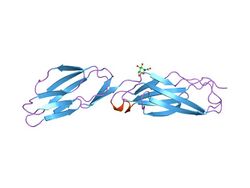Biology:Intercellular adhesion molecule
From HandWiki
| Intercellular adhesion molecule (ICAM), N-terminal domain | |||||||||
|---|---|---|---|---|---|---|---|---|---|
 structure of the two amino-terminal domains of human intercellular adhesion molecule-1, icam-1 | |||||||||
| Identifiers | |||||||||
| Symbol | ICAM_N | ||||||||
| Pfam | PF03921 | ||||||||
| Pfam clan | CL0011 | ||||||||
| InterPro | IPR013768 | ||||||||
| SCOP2 | 1zxq / SCOPe / SUPFAM | ||||||||
| Membranome | 219 | ||||||||
| |||||||||
In molecular biology, intercellular adhesion molecules (ICAMs) and vascular cell adhesion molecule-1 (VCAM-1) are part of the immunoglobulin superfamily. They are important in inflammation, immune responses and in intracellular signalling events.[1] The ICAM family consists of five members, designated ICAM-1 to ICAM-5. They are known to bind to leucocyte integrins CD11/CD18 such as LFA-1 and Macrophage-1 antigen, during inflammation and in immune responses. In addition, ICAMs may exist in soluble forms in human plasma, due to activation and proteolysis mechanisms at cell surfaces.
Mammalian intercellular adhesion molecules include:
References
- ↑ "Leukocyte adhesion--structure and function of human leukocyte beta2-integrins and their cellular ligands". Eur. J. Biochem. 245 (2): 215–32. April 1997. doi:10.1111/j.1432-1033.1997.00215.x. PMID 9151947.
 |

